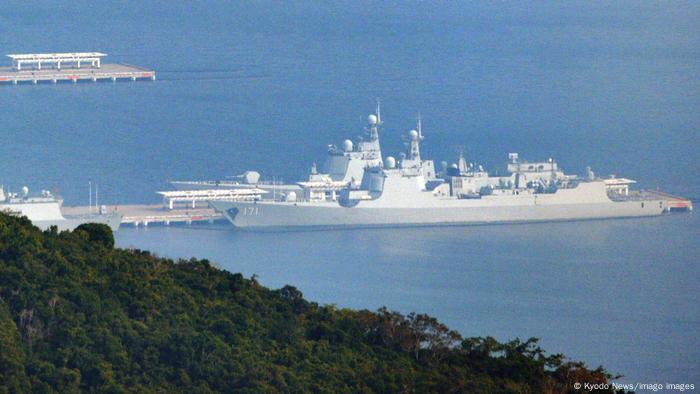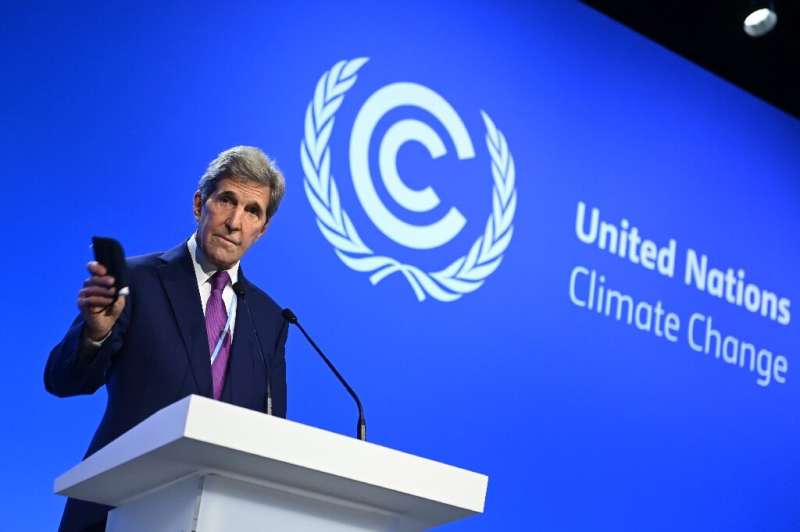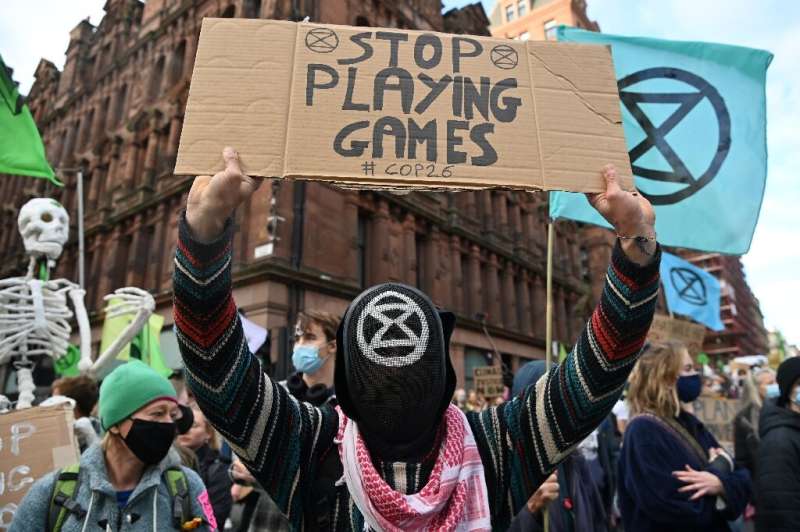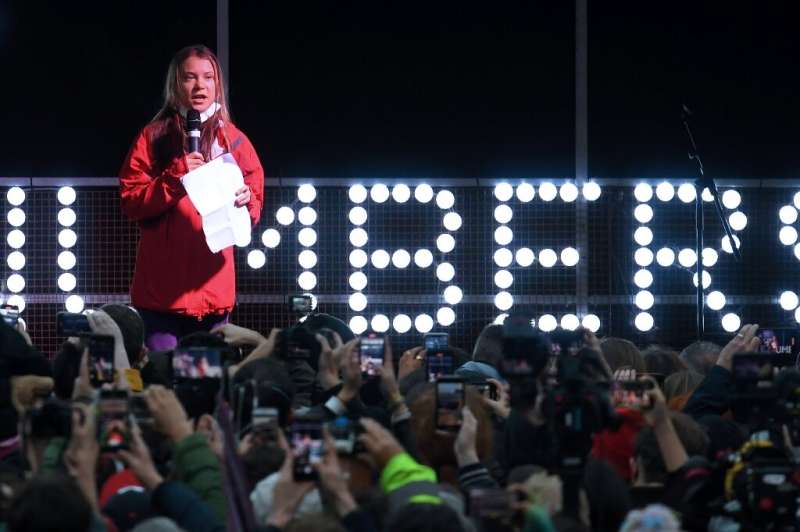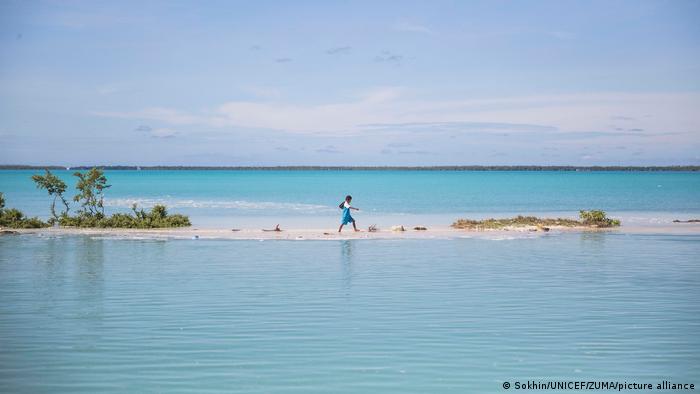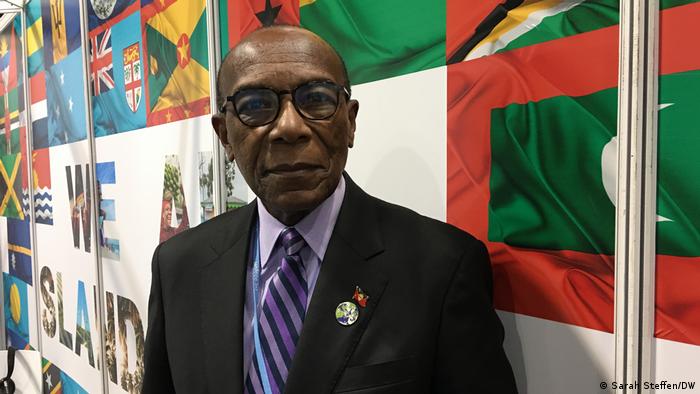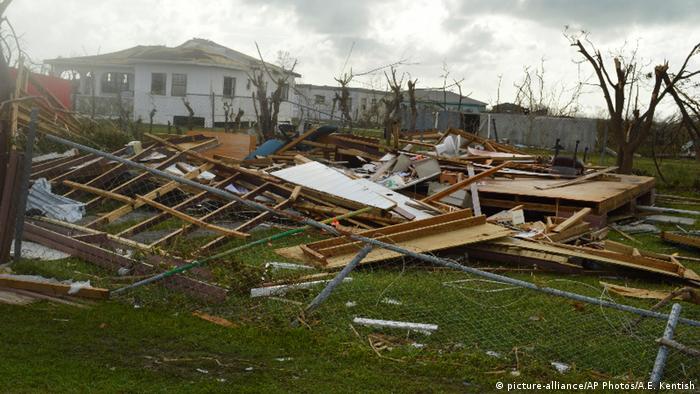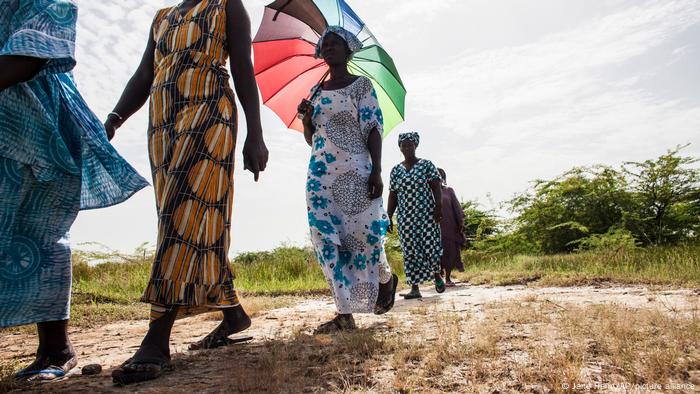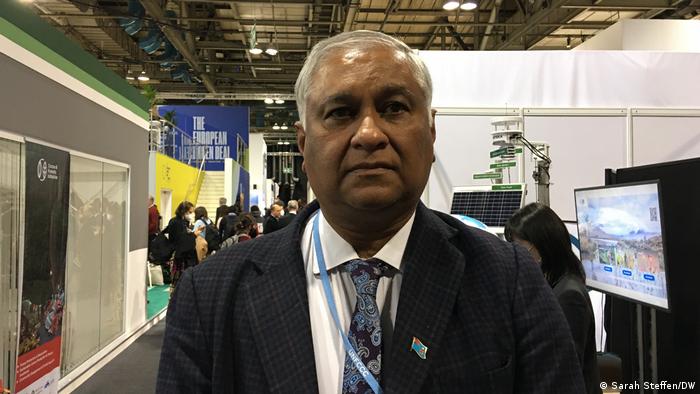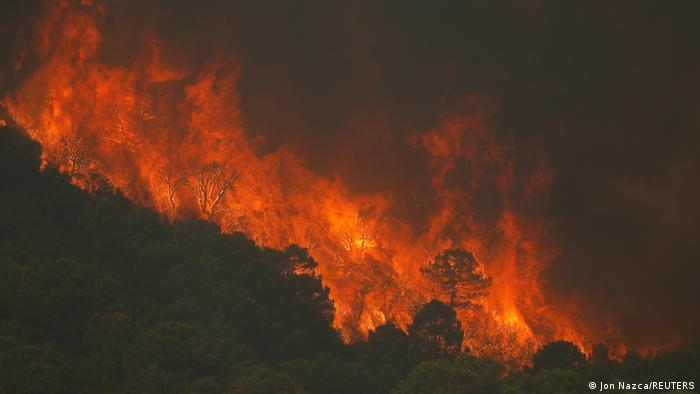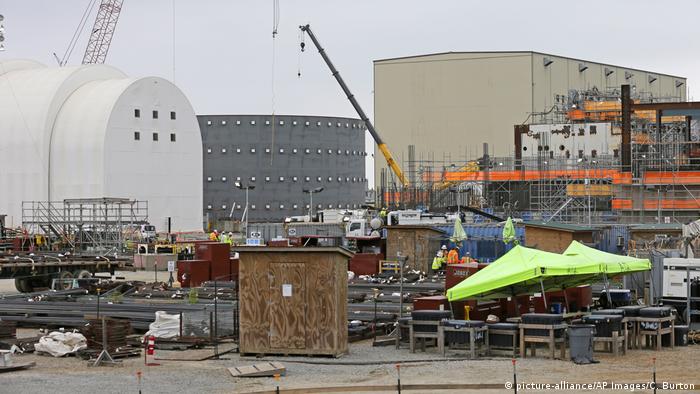Editorial
A year after fighting began, the war is intensifying. How many more civilians will pay?

Sun 7 Nov 2021 18.30 GMT
That wars are easy to begin and hard to end is a commonplace, but one which ambitious leaders still forget. Within weeks of launching his assault on the region of Tigray last November – saying its authorities had attacked a military camp – the Ethiopian prime minister announced that the operation had been completed. In fact, one year on, the conflict continues to escalate. Thousands of Ethiopians have died and millions have been forced from their homes. Atrocities have been committed by all parties, including massacres of civilians, extensive sexual violence and the use of food as a weapon. Last week, the prime minister, Abiy Ahmed, declared a state of emergency as the Tigray People’s Liberation Front (TPLF) suggested its soldiers might advance towards the capital. The Nobel peace prize laureate urged ordinary citizens to take up weapons and told them that “dying for Ethiopia is a duty [for] all of us”. A country already in dire straits is on the brink of catastrophe, Amnesty International warned on Friday.
Bolstered by Eritrean troops, federal forces briefly captured Tigray’s capital, but were forced out this summer. Though Mr Abiy has sought to buy more weapons and enlist more recruits, Tigrayan forces have broken through the blockade of their region and seized towns to the south, towards Addis Ababa. They could also seek to take the Djibouti corridor, the main trade artery, allowing them to reroute aid to Tigray, where desperate food shortages persist – and potentially to hit supplies to the capital. On Friday, eight anti-government factions vowed to ally with the TPLF – though the most significant element, the Oromo Liberation Army, already fights alongside it.
The conflict is growing both broader and more entrenched. Many in Ethiopia now fear that the TPLF is set on regaining the political dominance it held for decades before Mr Abiy’s rise. They point out that the prime minister won by a landslide in this year’s elections (albeit without polls in some regions). His opponents believe his power grab sparked the war, and many Tigrayans have also come to see the conflict as a matter of survival.
The only way out of this disaster is through negotiation. Mr Abiy could offer to restore vital services such as telecommunications and electricity to Tigray and do the utmost to facilitate aid in exchange for a halt in the Tigrayan advance. But emboldened Tigrayan commanders now seem less willing than ever to pause, while Mr Abiy seems to believe that a weak hand means he must press on.
While leaders refuse to talk, civilians face tragedy. The US has removed Ethiopia from a key trade programme and its special envoy to the Horn of Africa, Jeffrey Feltman, has said it will swiftly go further if there is no move to de-escalate – but acknowledged that such moves “don’t seem anywhere near”. The African Union, headquartered in Addis Ababa, is increasingly concerned, but appears to be making equally little headway; Tigrayans say it has favoured the federal government.
The emergency proclamation gives sweeping powers to a government which has already carried out mass arrests of Tigrayans and other critics. Encouraging civilians to take up arms, forming untrained and unaccountable militias, increases the risk of further atrocities – especially as hate speech circulates widely, primarily targeting Tigrayans. Tackling that should be an immediate priority. Facebook – accused of fanning ethnic hatred in Ethiopia and elsewhere by a whistleblower – took down a post by Mr Abiy “for inciting and supporting violence”, but others remain unchecked. Governments must exert maximum pressure not only upon the warring parties to end their conflict and protect civilians, but also upon social media platforms to prevent the fomenting of hatred.
By CARA ANNA

1 of 3
Ethiopian military parade with national flags attached to their rifles at a rally organized by local authorities to show support for the Ethiopian National Defense Force (ENDF), at Meskel square in downtown Addis Ababa, Ethiopia Sunday, Nov. 7, 2021. (AP Photo)
NAIROBI, Kenya (AP) — A new round of deadly attacks and forced conscription has begun against ethnic Tigrayans in an area of Ethiopia now controlled by Amhara regional authorities in collaboration with soldiers from neighboring Eritrea, people fleeing over the border to Sudan tell The Associated Press as the yearlong war intensifies.
Three men who fled the western Tigray communities of Adebay and Humera in the past week described warnings from Amhara authorities against supporting the rival Tigray forces who are approaching Ethiopia’s capital, Addis Ababa, to press Prime Minister Abiy Ahmed to step aside.
Their threat led Ethiopia’s government to declare a state of emergency last week while the United States and other countries urged citizens to leave immediately. U.S. and African Union envoys have been holding urgent talks in Ethiopia in search of a cease-fire in a war that has killed thousands of people after political tensions with the Tigray forces who once dominated the national government turned deadly. The U.N. Security Council is expected to meet on Monday.
The new accounts confirm assertions by the U.S. and others that Eritrean soldiers remain in the Tigray region, and they indicate that pressure is growing on Tigrayans of mixed heritage who have tried to live quietly amid what the U.S. has alleged as ethnic cleansing in western Tigray.
As reports grew about the Tigray forces’ momentum, Amhara authorities at a public meeting in Adebay on Oct. 29 warned residents against supporting them, two men who fled to Sudan said.
“There are people working for (the Tigray forces). You should give them to us or we will kill you all together,” one who fled, 28-year-old Mawcha Asmelash, recalled authorities saying.
Five days later, he said, Amhara militia attacked. “I saw four people being killed on the run,” he said.
He and other men hid in the bush for two days, gathering information from local women and trying to judge whether it was safe to return. But the women estimated scores of men had been killed and residents had been forbidden to bury their bodies. The women urged them to flee.
Another man who fled Adebay, 36-year-old Berhane Gebremikael, confirmed the public meeting. He said he saw one man killed as he ran from Amhara militia and the Eritrean soldiers, who he said have a camp in the community.
“They called it revenge,” he said. He described a perilous situation for Tigrayan residents of Adebay who had remained during the war, with many changing their identity, paying bribes or using mixed heritage for a measure of protection. Berhane, whose mother is Eritrean, now fears he can’t return.
“Maybe the worst things will happen in the next days,” he said. “The international community should intervene.”
A man who fled to Sudan from the city of Humera, near the Eritrean border, told the AP he had stayed there because of his part-Tigrayan heritage, but last week Amhara authorities “started collecting people. Young men and boys are being forced to join the fighting.”
Again, it started with a public warning, 28-year-old Alemu Abraha said. Then Amhara authorities, along with Eritrean soldiers, started visiting homes at night to take people away. His friends were taken, he said, and he believes the men are being sent to the Amhara region, where most fighting has occurred in recent months.
Amhara regional spokesman Gizachew Muluneh did not respond to AP questions. Amhara regional officials have asserted that western Tigray is historically their land, and during the war witnesses and humanitarian workers have described scores of thousands of Tigrayans forced from communities there.
Meanwhile, reports of mass detentions of Tigrayans continue under the state of emergency. An Ethiopian Orthodox Church official in Addis Ababa, speaking on condition of anonymity for fear of retribution, said dozens of priests, monks, deacons and others had been detained in the capital because of their ethnicity. Ethiopian authorities have said they are detaining people suspected of supporting the Tigray forces.
The government-created Ethiopian Human Rights Commission in a statement noted with concern that “arrests appeared to be based on ethnicity” and included the elderly and mothers with children.
As the war closes in, Ethiopia’s government insists that life in the capital remains normal. On Sunday, scores of thousands of people rallied in Addis Ababa in a show of support, some carrying signs criticizing the international community, including foreign media.
There were also calls for peace amid the sometimes graphic calls to war. “Can they not discuss around a table?” said one demonstrator, Lemelem Selega, who also denounced those “who are spilling our soldiers’ blood.”
African Union special envoy Olesegun Obasanjo, a former Nigerian president, was briefing the AU Peace and Security Council on Monday about his meeting with Tigray leader Debretsion Gebremichael in the Tigray regional capital over the weekend. Tigray forces spokesman Getachew Reda called the discussion “very fruitful.” Obasanjo’s spokesman did not respond to questions.
The U.S. has not released details on special envoy Jeffrey Feltman’s meeting with Ethiopia’s prime minister last week, which the prime minister’s spokeswoman called “constructive.”
A year after the conflict started in northern Ethiopia, fears are growing that TPLF forces could soon reach Addis Ababa. In recent days, there's been an uptick in arrests of Tigrayan residents in the capital.
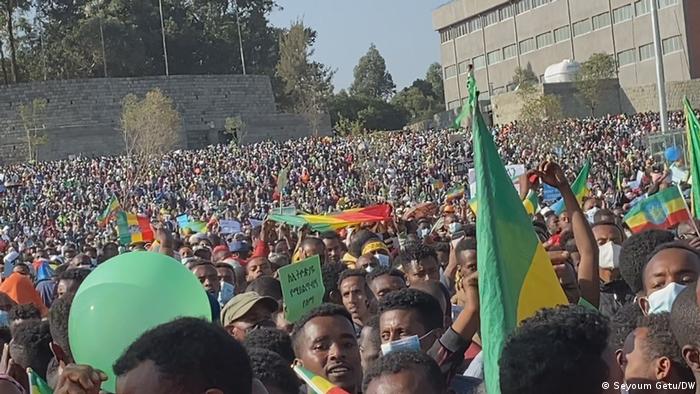
Thousands of pro-government protesters took to the streets of Addis Ababa on Sunday
When Adam* returned to his home after a haircut on the morning of Saturday, November 6, he saw his parents and sister being forced into a police van. With them were two other families living in the compound — all of them of Tigrayan origin. Before leaving, Adam's mother was able to lock the house, he said, taking with her the only key to their home.
"My father has a heart problem; he has a disease, and his medicine is in the house. He has to take the pill daily," said Adam, unable to hide his concern. "We are civilians […] I don't know what they are trying to do to us." His father had just been dismissed from his job at a government TV station, and his mother is a housewife. He has not yet been allowed to visit them them in detention.
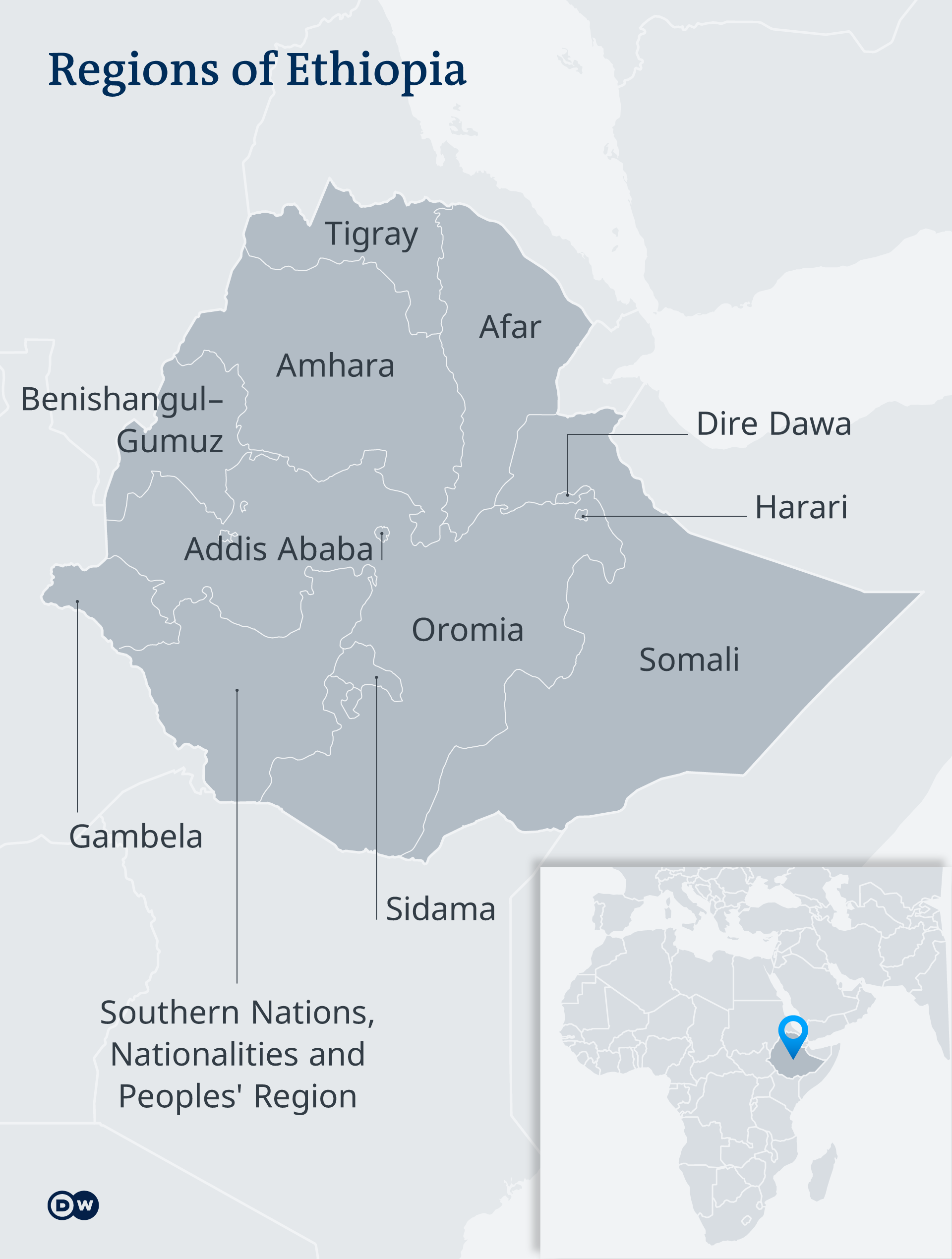
Since the beginning of the conflict in Tigray in November 2020, home searches and arbitrary arrests of residents of Tigrayan descent have become common in the Ethiopian capital. With the declaration of the state of emergency on Tuesday, the situation seems to be getting worse.
"They gave the power to the policemen to do anything, harass you and arrest you without any reason, and they can go and search for anything in your house," said Tigist*, a young woman who fled Tigray months ago. Policemen recently came to her apartment in Addis Ababa to ask for her ID, but she was at work.
Tigist was not born in Tigray, although her family is from there, which makes it easier for her to hide her ethnicity. Her friends, however, live in constant fear. "They are very worried, they don't want to stay out at nighttime," she explained. Several of her friends were detained but then released. Another one was arrested on the street after police forces asked for his ID. Tigist said he is still in detention.
No end in sight for Ethiopia's civil war
A police spokesperson insisted that those who have been arrested were directly or indirectly supporting the Tigray People's Liberation Front (TPLF), which the government labeled a terrorist organization last May. While it is still difficult to assess the scale of these arrests, human rights organizations are alarmed.
"We are very worried by the sweeping powers accorded to the security forces through the state of emergency and the risk that it gives legitimacy and legalizes the trends and practices we've been seeing in Addis Ababa almost since the beginning of the conflict," Laetitia Bader, Horn of Africa director for Human Rights Watch, told DW. "It's a very alarming situation for a community which has in many ways been living in a lot of fear for the last year."
Addis Ababa at risk?
The situation comes as Tigrayan forces, partly led by the TPLF, said they were advancing south toward Addis Ababa and east to the highway linking the capital to Djibouti. The organization announced they had joined forces with another group, the Oromo Liberation Army (OLA), who said it could be a matter of weeks before they reach the capital.
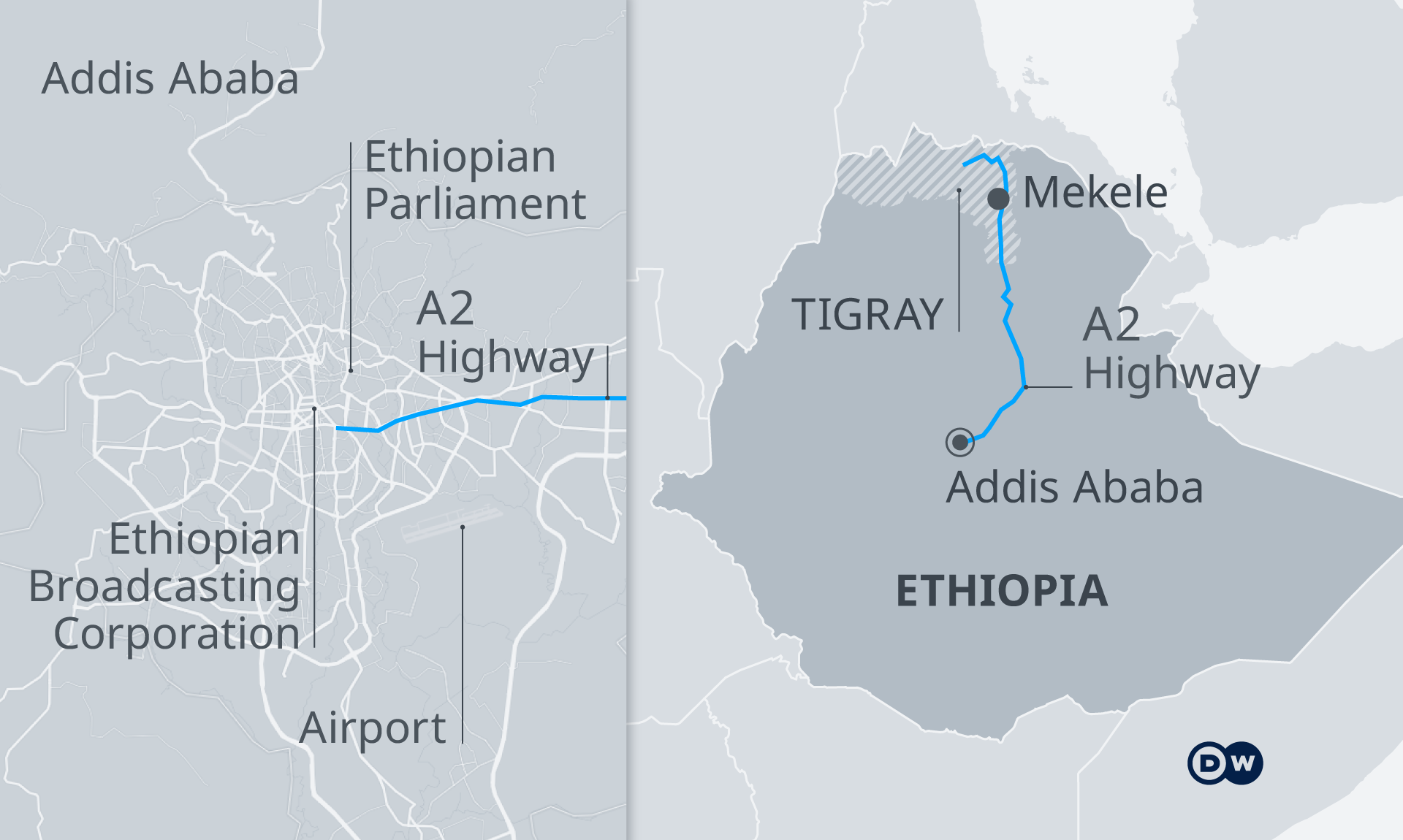
"[Prime Minister] Abiy's ship is sinking and sinking fast. The reason why they are rounding up innocent Tigrayans and Oromos in other parts of Ethiopia is most likely to use them as chips of bargain," Getachew Reda, a leader of the TPLF, said in a Twitter post on Saturday evening.
In light of the uncertain future, several embassies have advised their citizens to leave the country while commercial flights are still running. The US State Department has ordered the evacuation of all nonessential diplomatic staff.
But the Ethiopian government said Western actors, in particular media outlets, were overreacting, and dismissed rebel claims as propaganda. At the same time, citizens of Addis Ababa have been asked to mobilize, register their weapons and be ready to fight for their country. "For us, Ethiopians, dying for our sovereignty, unity and identity, is an honor," read a government statement on Saturday.
Analysts see this apparent contradiction as a way for the government to prepare for armed struggle while hoping to limit civil unrest.
"We could soon be in a scenario where the Tigray fighters are able to choke the Djibouti trade route, and you don't want panic-buying and hoarding in advance of that," said William Davison, senior Ethiopia analyst for the International Crisis Group. "So we can understand government efforts to try and calm things down, even if it runs against simultaneous official calls for all-out mobilization."
Residents have mixed feelings about the looming threat to the capital. One taxi driver said he wasn't worried but said in any case, most residents are living hand-to-mouth and can't afford to stock up on food and other essential items.
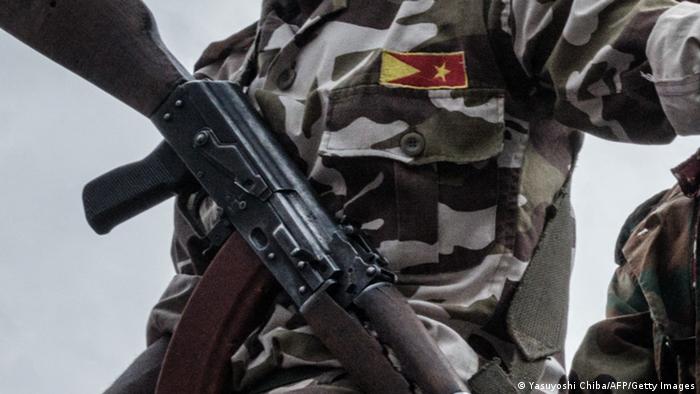
TPLF forces have said they've seized control of territory in the north of the country
Government support base on display
There's also widespread belief and hope among some Ethiopians that Prime Minister Abiy Ahmed can find a way to defeat the Tigrayan fighters. This was borne out on Sunday morning, when thousands of demonstrators flocked to a pro-government rally on Meskel Square, the capital's main gathering place.
Some of those protesting were members of the major opposition Ezema party. "We went out there to say that despite our different political opinions, when it comes to defending the sovereignty and unity of the country, we stand together," Nathenael Aberra, head of public relations for the Ezema party, told DW.
"I believe that what the TPLF and its allies are doing is posing a threat to national sovereignty and unity of the country, as well as to the security of our citizens. We cannot sit back and see their objectives unfold."
Dancing to chants celebrating Ethiopian soldiers, demonstrators waved Ethiopian flags and carried signs reading "Stop fake news Ethiopia," aimed at Western media organizations. In the midst of animated victory speeches, one voice did call for appeasement. Iconic Ethiopian singer Tariku Gankisi surprised the crowd as he made his way to the main stage to perform "Dishta Gena," one of this year's most popular hits.
"Enough! Our ears are bleeding […] Why are we going in front if we are going to die?" he yelled at the surprised crowd. "Enough with the cannons!"
Last-chance diplomatic efforts
Though a cease-fire still appears only a remote possibility, there seems to be a glimmer of hope emerging on the diplomatic front. The UN's Martin Griffiths and African Union High Representative to the Horn of Africa Olusegun Obasanjo reportedly landed in Mekele, the Tigray capital, on Sunday. According to Reuters, TPLF's Getachew Reda confirmed they were holding talks.
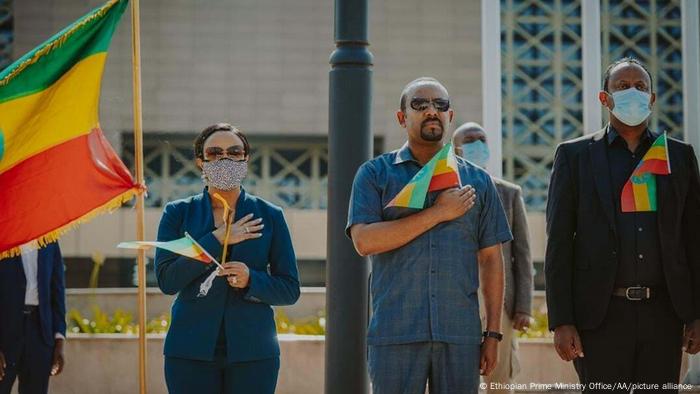
Prime Minister Abiy Ahmed took part in a memorial service for victims of the conflict last week
This as US special envoy Jeffrey Feltman spent two days in Addis Ababa, an effort deemed by many as the last chance for a negotiated settlement. One diplomatic source said Prime Minister Abiy Ahmed agreed to US-led mediation efforts, but others indicated the meetings hadn't gone well.
In the absence of a negotiated cease-fire, the situation still appears grim. The TPLF has denied that their arrival to Addis Ababa would cause a bloodbath, indicating that the TPLF and OLA only want to overthrow the government — but how this scenario would play out without confrontation remains unclear.
*Names have been changed to protect the sources
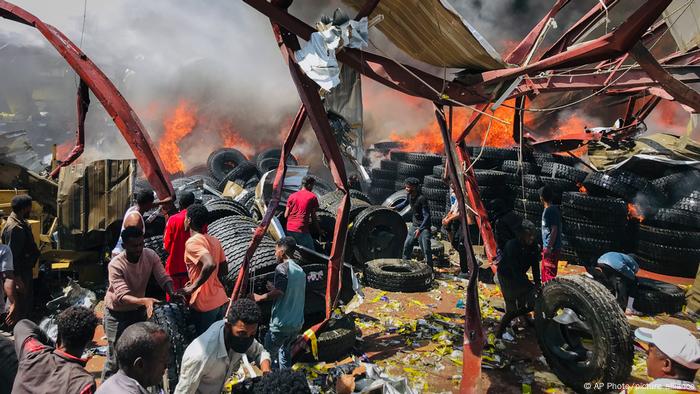
ETHIOPIA: TIGRAY CRISIS ONE YEAR ON
A city burns
Residents of Tigray's capital Mekele sift through wreckage following an airstrike by government forces on October 20. The military said it was targeting a weapons manufacturing facility operated by the Tigrayan People's Liberation Front (TPLF), which the rebel Tigray forces have denied.
123456789
Rebel troops are advancing toward the Ethiopian capital of Addis Ababa.
By Ellen Ioanes Nov 7, 2021, VOX
/cdn.vox-cdn.com/uploads/chorus_image/image/70109395/1236408634.0.jpg)
After a year of conflict, displacement, and growing humanitarian crises, Ethiopia’s civil war entered a new phase this week after a newly formed coalition of Tigrayan rebels and other minority groups began their advance on the federal capital of Addis Ababa.
The civil war, which began in November last year, has already killed thousands and displaced millions more; the UN says there have been brutal human rights violations on all sides, including a federal blockade of badly needed humanitarian aid into the northern Tigray region.
Now, the Tigrayan People’s Liberation Front, or TPLF, has responded by marching on the Ethiopian capital, Addis Ababa, along with a number of other rebel groups that have joined with the TPLF in opposition to Ethiopian Prime Minister Abiy Ahmed. While reports vary regarding their progress toward the capital, rebel forces may be as close as about 100 miles away, a spokesperson for the Oromo Liberation Army told CNN.
TPLF representatives in Washington, DC, announced the new coalition, called the United Front of Ethiopian Federalist and Confederalist Forces, on Friday, and made clear its intention to oust Abiy.
“Time is running out for him,” Berhane Gebrekristos, a former Ethiopian ambassador to the US and a TPLF leader, said during the announcement.
The coalition represents a new chapter in the conflict; previously, the TPLF, while powerful, has nonetheless been a minority force fighting against the federal government, but the advance on Addis Ababa marks a potential shift in the conflict’s momentum.
In addition to the TPLF, there are eight other groups in the new coalition; of those, the OLA is among the most prominent.
The OLA represents the Oromo ethnic group, of which Abiy himself is a member. Previously, Abiy has enjoyed the support of the Oromo and Amhara people; however, a spate of arrests and murders of Oromo leaders and activists, in addition to economic and political marginalization, have turned many Oromo against Abiy.
The seven other factions in the opposition coalition represent other ethnic groups, of which there are about 80 in Ethiopia. Upon his election, Abiy declared his government would distribute resources and power equally; however, the coalition announced their alliance on Friday “in response to the scores of crises facing the country” under his rule.
“The next step will be to organize ourselves and totally dismantle the existing government, either by force or by negotiation ... then insert a transitional government,” Mahamud Ugas Muhumed, a representative of the Somali State Resistance, one of the coalition groups, said.
But while the alliance brings together other minority groups, all of which have militant factions, it’s yet unclear how effective the coalition will be in its push to depose Abiy.
“I don’t think it will have that much of an impact,” Gedion Timothewos, Ethiopia’s attorney general and justice minister, said during an online news conference Friday, calling the coalition a “publicity stunt.”
Some external experts, however, disagree. William Davison, a senior analyst with the International Crisis Group, told the New York Times this week that the coalition indicates “that the political tides are changing” in Ethiopia.
If nothing else, the coalition’s advance toward Addis Ababa appears to be causing anxiety in the capital. OLA forces report that they are about 100 miles from Addis Ababa, while other sources put the figure at 200 miles. The coalition also says it has been able to take strategic cities on the way. While the Abiy government says the rebels are exaggerating their victories, the government has also called on retired soldiers to pick up their weapons and fight the advancing forces.
“Dying for Ethiopia is a duty for all of us,” Abiy said last week.
Ethiopia’s civil war is the product of longstanding ethnic tensions
The past month has seen further escalation of the civil war between the Tigrayan forces and Abiy’s administration, which started a year ago when TPLF forces launched what they described as a preemptive strike against a federal military base in Tigray.
Although the Tigrayan people are a minority ethnic group in Ethiopia, with a population of roughly 6 million concentrated in the northern state of Tigray, they emerged as a powerful force in the 1970s against Ethiopia’s Marxist military dictatorship, after years of marginalization.
Eventually, the TPLF dominated the coalition Ethiopian People’s Revolutionary Democratic Front, which overthrew the dictatorship in 1991. Tigrayan politicians led the government and dominated the coalition for nearly 30 years, overseeing economic growth despite famine and conflict in the region.
But the TPLF-led government was also known for torturing detainees and harsh crackdowns on dissent; by the time Abiy emerged on the political scene, anti-government protests had forced the previous prime minister to step down.
In the space of just three years, Abiy purged Tigrayan leadership from the federal government, essentially stripping the group of much of its former political power at a national level.
However, the state of Tigray is still under TPLF control, despite Abiy’s best efforts to centralize power. The TPLF’s resistance to the Abiy government — most notably by holding regional parliamentary elections in September 2020, despite Abiy’s decision to postpone them throughout the country — quickly spiraled into a full-blown conflict.
After early victories for Ethiopia’s national armed forces, the TPLF has been able to push back, recapturing the Tigrayan capital Mekele in June. Now, the group is gaining ground — as well as political and military support — with the new coalition.
But the recent developments have come at great cost for Tigray, as thousands have died in the conflict and 2 million have been displaced, both internally and externally.
The war has also created a humanitarian crisis: Aid to Tigray slowed to a trickle in July due to a government blockade which prevented trucks with food, medical supplies, and fuel from entering the region. In September, UN humanitarian aid chief Martin Griffiths warned Tigray was on the verge of famine and called the crisis “a stain on our conscience” in an interview with the Associated Press.
Shortly thereafter, the Ethiopian government moved to expel seven UN officials from the country, accusing them of “meddling” in the nation’s affairs and diverting humanitarian aid to TPLF forces. The government had previously ordered the Dutch contingent of Médecins Sans Frontières (Doctors Without Borders), as well as the Norwegian Refugee Council, to cease operations.
In October, Ethiopian national defense forces began conducting airstrikes in Mekele, which have killed multiple children. While Abiy’s government has claimed it was targeting military installations, some witnesses say the airstrikes actually hit civilian targets. The central government denied intentionally targeting civilians, according to Reuters, and communications blackouts in the region make verification difficult.
After a year of war, the US is stepping up its response
So far, Western leaders have made statements calling for an end to hostilities and warning of the dire humanitarian situation, but now are beginning to back up their admonitions with real consequences for Ethiopia’s central government.
Notably, the US suspended Ethiopia from the African Growth and Opportunity Act, or AGOA, on Tuesday “for gross violations of internationally recognized human rights.”
AGOA allows certain countries to export goods duty-free to the US, and suspending Ethiopia’s participation will be a serious economic blow; last year, Ethiopia shipped $245 million worth of goods to the US under AGOA, according to Al Jazeera — nearly half all its exports to the US.
President Joe Biden’s administration has also sent Jeffrey Feltman, its Horn of Africa envoy and a veteran diplomat, to try and negotiate a deescalation to the conflict after Abiy declared a six-month state of emergency earlier this month. However, Feltman told Reuters, “We’re not getting much response, the military logic is still prevailing.”
Biden has threatened further sanctions against Ethiopian leadership, and a bipartisan group of senators has put forward legislation specifically targeting the actors prolonging and benefiting from the conflict, but as Politico’s Nahal Toosi points out, both sides of the conflict seem unwilling to budge.
“The problem is that you have multiple objects that heretofore have proven largely unmovable,” Toosi quotes an unnamed State Department official as saying about the situation. “It remains to be seen whether the shifting dynamic will cause at least one of those objects to show a little more flexibility.”
Ethiopia's wartime emergency decree sets capital on edge
Issued on: 08/11/2021 -
Nairobi (AFP) – A rebel leader fighting Ethiopia's government says his troops are near the capital and preparing another attack, predicting the war would end "very soon" as diplomats rush to negotiate a ceasefire.
Jaal Marroo, commander of the Oromo Liberation Army (OLA), warned Prime Minister Abiy Ahmed that pro-government fighters were defecting and the rebels were very close to victory.
"What I am sure (of) is that it is going to end very soon," Jaal, whose real name is Kumsa Diriba, told AFP in an interview Sunday.
"We are preparing to push for another launch, and for another attack. The government is just trying to buy time, and they are trying to instigate civil war in this country, so they are calling for the nation to fight."
The OLA and its allies, the Tigray People's Liberation Front (TPLF), have claimed several victories in recent weeks, taking towns some 400 kilometres (250 miles) from the capital, and have not ruled out marching on Addis Ababa
Jaal said his fighters were even closer -- some 40 kilometres (25 miles) from the capital -- and had "never moved (back) an inch" from territory they controlled.
AFP could not independently confirm this claim. Much of the conflict-affected zone is under a communications blackout and access for journalists is restricted, making battlefield positions difficult to verify.
The government has rejected suggestions the rebels are within striking distance of Addis Ababa, but has ordered the capital to prepare to defend itself, while foreign embassies have withdrawn staff.
"While we are being tested on many fronts, our collective will to realize the path we have embarked upon has strengthened us," Abiy tweeted Monday, a day after tens of thousands marched in Addis Ababa in support of the government.
The threat of fresh rebel advances has spurred efforts by foreign envoys to broker a settlement to a conflict that has killed thousands and inflicted atrocities and starvation on civilians.
On Sunday, the African Union's high representative for the Horn of Africa, Olusegun Obasanjo, sat down with TPLF leader Debretsion Gebremichael in Tigray's capital Mekele.
The same day, the UN undersecretary for humanitarian affairs, Martin Griffiths, also visited Mekele where he met the "de-facto authorities" there, said a spokesperson.
Abiy, winner of the 2019 Nobel Peace Prize, sent troops into Tigray in November last year to topple the TPLF, accusing them of attacking military bases.
In August, the OLA and TPLF -- both designated terrorist groups by the government -- announced they had brokered an alliance to fight against a common enemy, despite the two groups holding historic grievances.
© 2021 AFP
LUCY KASSA
SPECIAL TO THE GLOBE AND MAILPUBLISHED YESTERDAY
:format(jpeg)/cloudfront-us-east-1.images.arcpublishing.com/tgam/EODVU4II45DPXDATDGDCKQ2ZDQ.png)
The Globe and Mail has identified the Awash Arba detention camp in Ethiopia, pictured in a satellite photo, as one of three of the largest detention centres for Tigrayans arrested during the country's civil war.
Medhanye, a 31-year-old Ethiopian of Tigrayan ethnicity, was watching a soccer match with his friends at a café in Addis Ababa when the police suddenly arrived. After demanding their identity cards, which show their ethnicity, the police separated 11 Tigrayans and took them to a site where hundreds of others were being held.
At dawn the next morning, they were forced onto three buses and driven to a secret detention camp in the Afar region. “They did not explain our crime,” Medhanye said.
For the next 93 days, he said he was imprisoned – and often tortured – at the camp with hundreds of other Tigrayans, until he finally managed to pay a bribe for his release last month.
Disappearances, ethnic profiling and mass arrests of Tigrayans have become increasingly common this year, especially after territorial gains by Tigrayan rebel forces in the escalating civil war, according to human rights groups and other independent sources.
Over the past week, as rebels advance closer to the Ethiopian capital, Addis Ababa, the cycle of detention is being repeated. Federal police in the capital are rounding up hundreds of Tigrayans on the streets or in house-to-house searches and taking them to unknown locations, numerous media reports say.
Canada will keep only essential staff in Ethiopia as security in the country deteriorates
Abiy is starving Tigray. It’s time to invoke the Responsibility to Protect
Ethiopians denounce the U.S. at rally to back government’s campaign against rebel forces
Under a newly proclaimed state of emergency, the Ethiopian police are empowered to arrest anyone suspected of “collaborating with terrorist groups” and to detain them for the duration of the state of emergency, even without an arrest warrant. “The sweeping nature of this state of emergency is a blueprint for escalating human rights violations, including arbitrary detention,” Amnesty International said in a statement on Friday.
Amnesty also warned of a “significant rise” in social-media posts that incite violence against Tigrayans and use ethnic slurs against them. Ethiopian government officials have denounced Tigrayan leaders as “cancer,” “weeds” and “rats.”
By most estimates, thousands of Tigrayans have been arbitrarily detained since the war began in the Tigray region a year ago. One Tigrayan political party, Salsay Weyane, estimates that 20,000 to 30,000 Tigrayans have been held at several detention centres outside the main war zones.
:format(jpeg)/cloudfront-us-east-1.images.arcpublishing.com/tgam/JSYTPUDUNJIMFFL6LNQEXOKBAI.jpg)
Tigray women who fled the conflict in Ethiopia's Tigray region, sit on a hill top overlooking Umm Rakouba refugee camp, in Qadarif, eastern Sudan, in this file photo taken Thursday, Nov. 26, 2020.NARIMAN EL-MOFTY/THE GLOBE AND MAIL
The Globe and Mail interviewed 15 people whose family members and friends disappeared after they were detained by Ethiopia’s federal police over the past several months. The Globe also talked to people who had been released from detention camps after paying bribes. And with the use of smuggled phones, The Globe talked to detainees who are still inside the secret camps.
Using satellite images, based on maps and information from the detainees, The Globe has identified the location of three of the biggest detention centres. Two of the big camps, Awash Arba and Awash Sebat, are in the Afar region. The third one, Gelan warehouse, is in the outskirts of Addis Ababa.
The accounts by the detainees and their families all confirm that there is a pattern of torture and abuse at the detention camps. The Globe has withheld the full names of the interviewed people to protect them from possible retribution.
At the Awash Sebat detention camp, Medhanye said he was tortured often. “The harshest was on Aug. 6,” he told The Globe. “They forced us to squat barefoot in a very hot pavement inside the camp. As we squatted barefoot, they were whipping us in the back. There were teens as young as 12 between us, screaming in pain. That day they tortured me until I lost consciousness.”
After three months in detention, Medhanye was released last month when his friends and family raised enough money to pay a bribe of 100,000 birr (about $2,600) to the camp authorities. But those who cannot afford to pay are still in the camps, often undergoing torture and the threat of execution, he said.
In the capital city, the districts of Hayahulet, Teklehaimanot and Kaliti are largely inhabited by ethnic Tigrayans. Witnesses told The Globe how police officers target Tigrayans in those districts and round them up.
Tsion, an office worker in the capital, said the police had detained her friend Genet, a 27-year-old Tigrayan housewife in the city, about four months ago. “Me and her family have not heard about her for months,” she said. “We don’t have information about where she was taken after she was detained in Addis.”
Kiflay, 26 and Haftom, 22, were walking home from their workplace in Addis Ababa on the evening of July 1 when they were detained by security officers who checked their ethnicity on their identity cards. The two brothers, ethnically Tigryans, had moved to the capital six years ago and had been working as carpenters since then.
The brothers were held in the district’s police station for a day. But the following day they disappeared.
For almost four months, their 31-year-old cousin Merhawi has been searching for them. “I don’t know if they are alive,” he told The Globe.
“They never appeared in court. They just vanished from the police station. The officers refused to tell me their whereabouts. I tried all means and even paid a bribe to the officers to get information, all with no success.”
Using a smuggled phone, The Globe talked to a 23-year-old Tigrayan detainee at Awash Arba camp. He had worked as a day labourer at construction sites in Addis Ababa until he was arrested almost five months ago. He estimates that there are about 900 Tigrayan detainees at the camp.
“They beat us every day,” he said. “They harass and threaten to execute us. It is so difficult, I have no words to describe the suffering. We are all low-profile Tigrayans with no military or political background or social media engagement. We have never appeared in court.”
Some detainees, released after paying bribes, said they sometimes heard gunshots at Awash Sebat camp and feared that people were being executed.
Ashenafi, a Tigrayan man who spent three weeks in the Awash Sebat camp until he paid a bribe of 81,000 birr (about $2,100) for his release, said he saw five young detainees being taken to a room where gunshots were later heard on a night in early August.
“Their heads were shaved,” he said. “I could see the officers brutally beating them outdoors. They were bleeding. Then the officers took them to a dark room. At night I heard shootings coming from that dark room. I don’t know what exactly happened to the five young men. But from that day on, the room was empty, and officers were no longer around to keep it.”
Other witnesses described several shootings at night at the camp, including that day’s incident.
Human Rights Watch, in a report in August, said the Ethiopian authorities had arbitrarily detained and forcibly disappeared a growing number of ethnic Tigrayans in Addis Ababa – including journalists – after the rebels captured the Tigrayan capital, Mekelle, in late June.
The report documented the same pattern that the detainees had described: Tigrayans were stopped and arrested on the streets, in cafés and in their homes and workplaces; their ethnicity was checked; they were taken to police stations and later transferred secretly to unidentified locations.
“Lawyers and families discovered, often weeks later and sometimes only informally, that some detainees were being held in the Afar region, over 200 kilometres from Addis Ababa,” the report said.
The Globe contacted Billene Seyoum, a spokesperson for Prime Minister Abiy Ahmed, to seek comment on the allegations in this article. She did not reply.
With a report by Geoffrey York in Johannesburg





